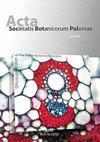波兰植物组织的低温保存:研究贡献、现状和应用
IF 1.1
4区 生物学
Q3 PLANT SCIENCES
引用次数: 3
摘要
植物无性繁殖材料的低温保存是一种高效、安全的种质资源保存方法,在世界范围内得到越来越广泛的应用。在波兰,目前有四个冷冻库用于长期植物保护项目。然而,离体繁殖的植物组织只占其中储存材料的一小部分。迄今为止,我国已经开发并采用了低温贮藏技术,用于观赏植物(玫瑰、菊花和地生植物)、作物物种(马铃薯和大蒜)、森林树种(栎属和黄曲霉属)和一些蕨类植物。波兰的研究人员已经使用龙胆属的悬浮培养和Lamprocapnos spectabilis的茎尖来提高冷冻保存的知识。需要更好地了解低温保存的好处及其在植物生物多样性保护计划中的广泛实施。这篇综述的目的是提供一个简明的科学贡献,现状和低温技术在波兰保存体外培养来源的植物组织的应用。首先,本文讨论了利用细胞悬浮液的研究成果,以及利用纳米颗粒和植物提取物提高低温保存效率的相关进展。其次,综述了观赏植物(玫瑰、辐射突变体、植物嵌合体、灯柱、地生植物)、农作物(马铃薯、大蒜)、林木、蕨类植物等在低温保存方面的应用和进展。本文章由计算机程序翻译,如有差异,请以英文原文为准。
Cryopreservation of Plant Tissues in Poland: Research Contributions, Current Status, and Applications
Cryopreservation of vegetatively propagated plant material is an increasingly widely used method for the efficient and safe storage of germplasm resources around the world. In Poland, there are currently four cryobanks in use for long-term plant protection programs. However, plant tissues propagated in vitro constitute only a small portion of the accessions stored in them. To date, cryogenic storage techniques have been developed and adopted in this country for ornamental plants (roses, chrysanthemums, and geophytes), crop species (potato and garlic), forest tree species (the genera
Quercus
and
Fraxinus
), and some ferns. Polish researchers have used suspension cultures of
Gentiana
spp. and shoot tips of
Lamprocapnos spectabilis
to improve cryopreservation knowledge. A better understanding of the benefits of cryopreservation and its widespread implementation in plant biodiversity conservation programs is required. The objective of this review is to provide a concise synthesis of the scientific contributions, current status, and applications of cryogenic techniques for the conservation of in vitro culture-derived plant tissues in Poland. First, the results contributing to research that has been achieved using cell suspensions and advances related to the use of nanoparticles and plant extracts to improve cryopreservation efficiency are discussed. Then, the applications and advances in cryopreservation of ornamental plants (roses, radiomutants, plant chimeras,
Lamprocapnos
spp., and geophytes), crop species (potato and garlic), forest trees, and ferns are summarized.
求助全文
通过发布文献求助,成功后即可免费获取论文全文。
去求助
来源期刊
CiteScore
2.00
自引率
10.00%
发文量
18
审稿时长
1 months
期刊介绍:
The journal has been published since 1923 and offers Open Access publication of original research papers, short communications, and reviews in all areas of plant science, including evolution, ecology, genetics, plant structure and development, physiology and biochemistry.

 求助内容:
求助内容: 应助结果提醒方式:
应助结果提醒方式:


